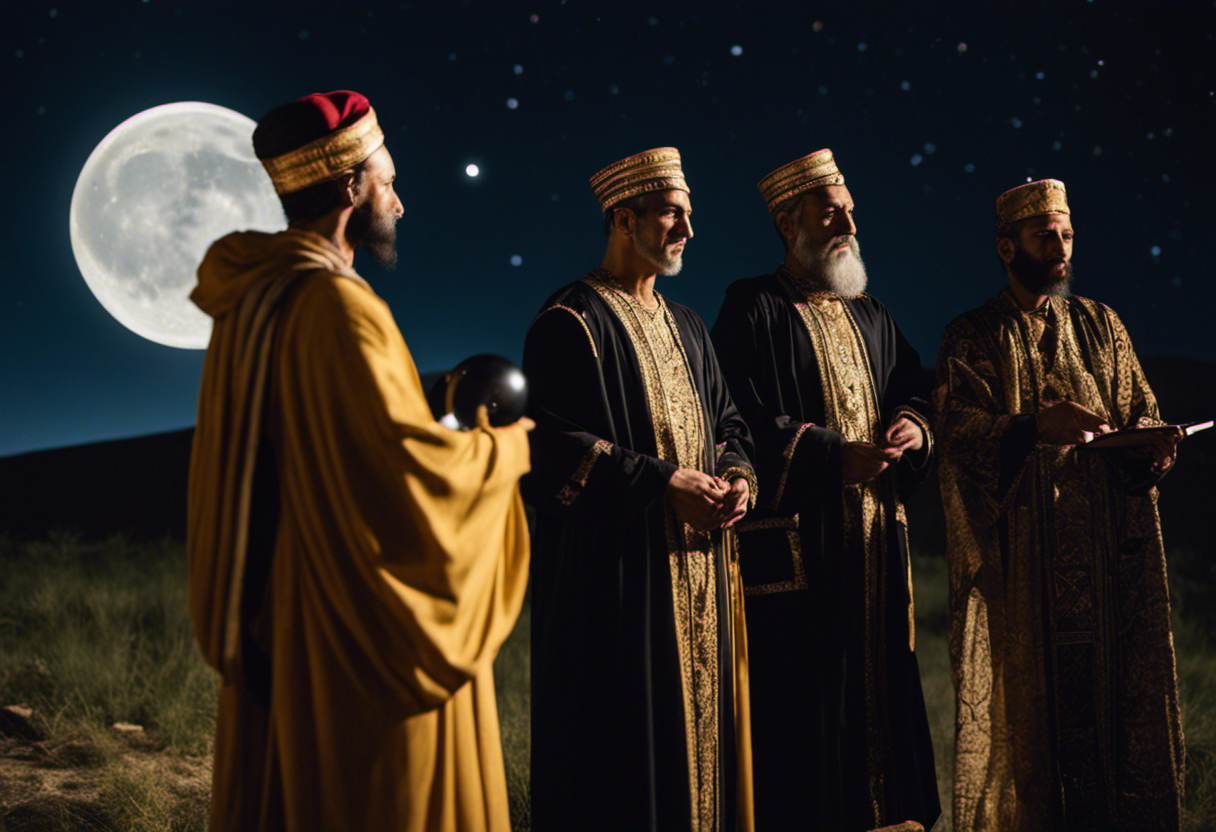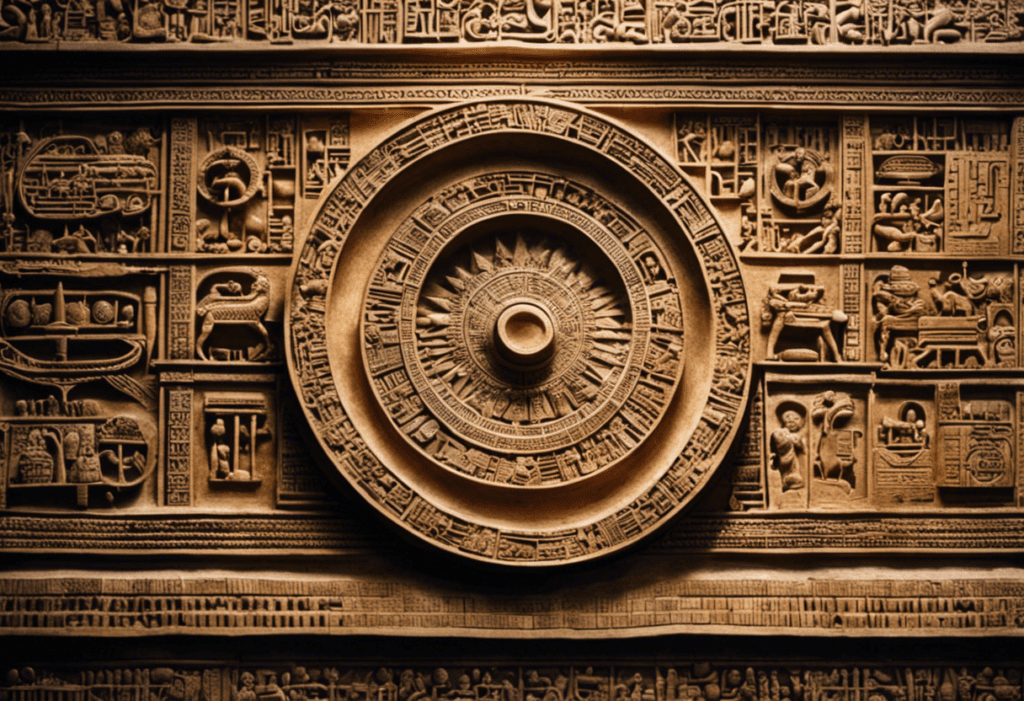In the ancient civilization of Babylon, a remarkable calendar system was established, intricately tied to the ever-changing phases of the Moon. This article delves into the depths of the lunar basis of the Babylonian calendar, exploring the significance of lunar observations and their role in timekeeping, astrology, and societal practices.
By unraveling the mysteries surrounding this lunar foundation, we gain a deeper understanding of the intricate workings of ancient Babylonian society and their connection to celestial phenomena.
Key Takeaways
- The Babylonians closely monitored the moon’s movements and phases, using the lunar cycle of approximately 29.5 days as the basis for their lunar calendar.
- Intercalation techniques were developed to reconcile the lunar and solar calendars, which did not always align perfectly.
- Lunar observations played a central and significant role in Babylonian astrology, with the moon believed to influence human behavior and events on Earth.
- The Babylonians’ understanding of lunar phases influenced their understanding of the universe, and their advanced astronomical knowledge shaped their understanding of celestial events.
The Moon’s Influence on the Babylonian Calendar


The Moon’s gravitational pull played a pivotal role in determining the length and structure of the Babylonian calendar. The Babylonians were keen observers of the celestial bodies, and they closely monitored the moon’s movements and phases. They noticed that the moon completes a full cycle of phases, from new moon to full moon and back to new moon, in approximately 29.5 days. This lunar cycle became the basis for the Babylonian lunar calendar.
The Babylonians believed that the moon had a significant effect on various aspects of their lives, including agriculture, hunting, and religious ceremonies. They observed that certain activities were more successful when aligned with specific lunar phases. For example, they associated the new moon with new beginnings and the full moon with abundance and fertility.
To track the moon’s effect on these activities, the Babylonians divided the lunar cycle into different phases. Each month, known as a luni-solar month, began with the first sighting of the new moon. This marked the start of the month, and the Babylonians would perform rituals and offerings to honor the moon. They would then observe the moon’s phases and adjust their activities accordingly.
The Babylonian lunar calendar consisted of twelve or thirteen months, alternating between 29 and 30 days. To account for the discrepancy between the lunar and solar year, they periodically added a 13th month. This ensured that their calendar remained in sync with the seasons.
Understanding Lunar Phases in the Babylonian Calendar


Our research aims to delve deeper into the Babylonian calendar by comprehending the significance behind the intricate interplay of lunar phases within the system. The Babylonians were meticulous in their observations of celestial bodies, particularly the moon. They recognized the importance of lunar phase calculations in determining the passage of time and the occurrence of significant events.
The Babylonian calendar was primarily based on lunar cycles, with each month beginning on the first visible crescent of the new moon. However, the Babylonians observed that the lunar cycle patterns did not always align perfectly with the solar year. This led them to develop intercalation techniques to reconcile the lunar and solar calendars.
By studying Babylonian astronomical texts and cuneiform tablets, we aim to uncover the methods used by the Babylonians to calculate lunar phases and establish a more comprehensive understanding of their calendar system. This research will shed light on the ancient Babylonians’ sophisticated astronomical knowledge and their ability to accurately track the lunar cycle, as well as provide insights into their cultural and religious practices.
Observing the Moon: A Key Aspect of the Babylonian Calendar


Through meticulous observations and calculations, Babylonian astronomers integrated the moon’s movements into their calendar system, recognizing its crucial role in marking time and determining significant events. The Babylonians were keen astronomers who carefully observed the moon’s phases and movements to ensure the accuracy of their calendar. They recognized that the moon’s cycle of phases, from new moon to full moon and back, took approximately 29.5 days. This lunar month formed the basis of their calendar system, which consisted of 12 lunar months totaling 354 days.
To maintain calendar accuracy, the Babylonians closely monitored the moon’s position in the sky and noted any variations in its cycle. They observed that the moon’s path across the sky shifted slightly each month, a phenomenon known as the lunar month’s anomalistic month. This careful tracking allowed them to make adjustments to their calendar system to ensure it remained in sync with the moon’s actual movements.
The Babylonians also paid attention to lunar eclipses, which occur when the Earth casts its shadow on the moon. These events were considered highly significant and were recorded as omens, believed to foretell future events. By incorporating lunar observations into their calendar, the Babylonians were able to accurately predict and commemorate celestial events, religious festivals, and agricultural cycles.
The Lunar Cycle and Timekeeping in Babylon


The Babylonians developed a sophisticated system of timekeeping based on the lunar cycle. They observed the movements of the moon and used these observations to create a calendar that closely aligned with the lunar phases.
This lunar calendar was an integral part of Babylonian society and played a significant role in their daily lives and religious practices.
Lunar Calendar Origins
An understanding of the origins of the lunar calendar is crucial in comprehending the cultural significance of timekeeping practices in ancient Babylon.
The Babylonians, known for their advancements in astronomy, developed a calendar based on the phases of the moon. This lunar calendar played a vital role in their daily lives, religious ceremonies, and agricultural practices.
The Babylonians observed the lunar cycles and made meticulous records of the moon’s appearance and disappearance. By tracking these observations over time, they were able to establish patterns and create a calendar that aligned with the lunar cycles.
This calendar not only provided a method for measuring time but also served as a guide for religious festivals and agricultural activities. The lunar calendar practices in ancient Babylon were a testament to their sophisticated understanding of celestial movements and their ability to integrate them into their society.
Babylonian Timekeeping Methods
In studying Babylonian timekeeping methods, one can observe the intricate relationship between the lunar cycle and the accurate measurement of time in ancient Babylon. The Babylonians were avid astronomers and made extensive use of lunar observations for their calendar. They developed sophisticated techniques to track the phases of the moon and determine the length of a lunar month, which averages around 29.5 days.
Their calendar was based on a lunisolar system, where months were aligned with lunar cycles and intercalary months were added to synchronize with the solar year. This allowed the Babylonians to accurately predict celestial events such as eclipses and solstices.
The Babylonian timekeeping techniques not only facilitated agricultural planning but also played a significant role in their religious and administrative practices. The lunar-based calendar served as a foundation for the development of later calendars in the ancient world.
Lunar Phases Significance
Frequently observed and meticulously documented, lunar phases held significant importance in Babylonian timekeeping, serving as a crucial factor in the accurate measurement of time in ancient Babylon.
The Babylonians recognized the symbolism and significance of lunar phases in their astrology, which influenced their religious beliefs and societal practices.
The lunar cycle, consisting of approximately 29.5 days, was divided into various phases such as new moon, crescent, first quarter, full moon, and last quarter. These phases were carefully observed and recorded, enabling the Babylonians to establish a lunar-based calendar.
The symbolism associated with each phase was used to interpret celestial events and predict future outcomes in astrology. The Babylonians believed that the lunar phases were closely linked to the gods and had a profound impact on their daily lives.
Thus, the accurate observation and interpretation of lunar phases played a crucial role in the Babylonian civilization’s understanding of time and its connection to the divine.
The Role of Lunar Observations in Babylonian Astrology


While there were various celestial bodies considered in Babylonian astrology, the role of lunar observations played a central and significant role in its practice. The Babylonians believed that the moon was a powerful force in influencing human behavior and events on Earth. They closely observed the lunar phases and used them to make predictions and guide their daily lives.
Here are three key aspects of the role of lunar observations in Babylonian astrology:
- Lunar Phases: The Babylonians tracked the waxing and waning of the moon to determine its position in the lunar month. They believed that different phases of the moon had different effects on human behavior and emotions. For example, a full moon was associated with heightened emotions and increased fertility.
- Lunar Eclipses: Lunar eclipses were considered significant celestial events in Babylonian astrology. They were believed to have a profound impact on the course of events and were often interpreted as omens. The Babylonians closely observed and recorded lunar eclipses to gain insights into future events.
- Lunar Divination: The Babylonians practiced lunar divination, which involved interpreting the placement and movement of the moon to predict the future. They believed that the moon’s position in relation to other celestial bodies could reveal important information about upcoming events and guide decision-making.
Tracking Lunar Events in the Babylonian Calendar


The accurate tracking of lunar events, such as phases and eclipses, was an essential aspect of the Babylonian calendar system. The Babylonians were meticulous in their observations of the moon, using it as a basis for their calendar and religious practices. Lunar observations allowed them to determine the length of a month, as well as predict celestial events that held significant cultural and religious importance.
The Babylonians understood that the moon goes through various phases, such as crescent, gibbous, and full. These phases were carefully recorded and used to determine the start and end of each month. Lunar eclipses were also observed and noted by the Babylonians. These celestial events were seen as omens, and their occurrence was believed to have an impact on the fortunes of individuals and the state.
The tracking of lunar events in the Babylonian calendar demonstrates the advanced astronomical knowledge possessed by this ancient civilization. It is evident that the Babylonians recognized the cyclical nature of the moon and its importance in measuring time. Their careful observations and record-keeping were crucial in developing a calendar system that accurately reflected the lunar cycles. These observations also played a significant role in their religious and cultural practices, highlighting the deep connection between the moon and the Babylonian society.
Unraveling the Significance of Lunar Observations in Babylonian Society


The significance of lunar observations in Babylonian society can be unraveled by examining their cultural and religious impact, as well as their influence on astronomical advancements.
The Babylonians placed great importance on the moon in their religious beliefs, viewing it as a divine entity that influenced their daily lives.
Additionally, their meticulous observations of lunar phases and movements allowed them to develop a sophisticated calendar system that guided their agricultural practices and societal events.
Cultural and Religious Impact
Cultural and religious practices in Babylonian society were profoundly influenced by the precise lunar observations that formed the basis of their calendar system. The impact of these observations was far-reaching, shaping various aspects of daily life and religious rituals.
• Cultural Impact:
- The Babylonians believed that the moon represented a divine entity, influencing their understanding of celestial events and their place in the universe.
- Lunar observations played a crucial role in determining the timing of agricultural activities, such as planting and harvesting, which were essential to Babylonian society’s survival.
- The lunar calendar also influenced the scheduling of religious festivals and ceremonies, which were deeply ingrained in Babylonian culture.
• Religious Influence:
- The Babylonians associated specific deities with different phases of the moon, leading to the development of lunar-based religious practices and rituals.
- Lunar observations were used to determine propitious times for religious activities, such as temple offerings and divination practices, which were believed to appease the gods.
- The lunar calendar served as a guide for Babylonian priests, enabling them to predict celestial events and interpret their significance in relation to religious beliefs.
Astronomical Advancements and Influence
Throughout history, astronomical advancements have continued to shape our understanding of the universe and its influence on various civilizations.
The Babylonians were among the first to develop a comprehensive calendar system based on celestial observations. Their understanding of the moon’s phases allowed them to establish a lunar calendar, which played a crucial role in their societal and religious practices.
The Babylonian calendar consisted of twelve lunar months, with each month beginning at the first sighting of the new moon. This astronomical progress not only facilitated their agricultural activities but also had significant societal implications.
The accurate prediction of lunar phases helped the Babylonians organize important religious ceremonies and events. Moreover, their ability to anticipate astronomical phenomena such as eclipses demonstrated their advanced knowledge and influence in the ancient world.
Conclusion
In conclusion, the Babylonian calendar was deeply rooted in the observation and understanding of lunar phases. The moon’s influence played a crucial role in timekeeping, astrology, and societal events.
By carefully tracking lunar events, the Babylonians were able to develop a sophisticated calendar system that allowed them to navigate the celestial world and make predictions about the future.
This lunar basis of the Babylonian calendar highlights their advanced knowledge and the importance they placed on the natural world.



